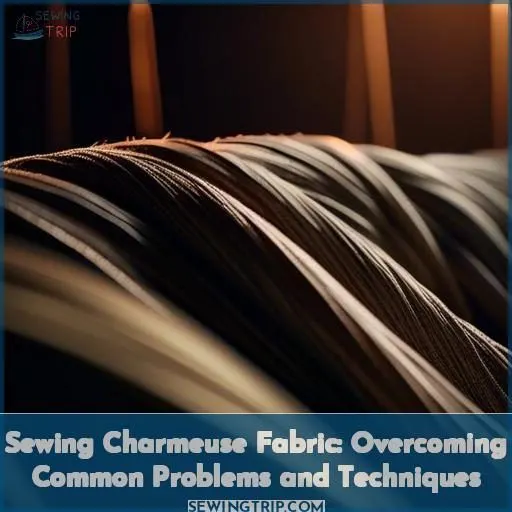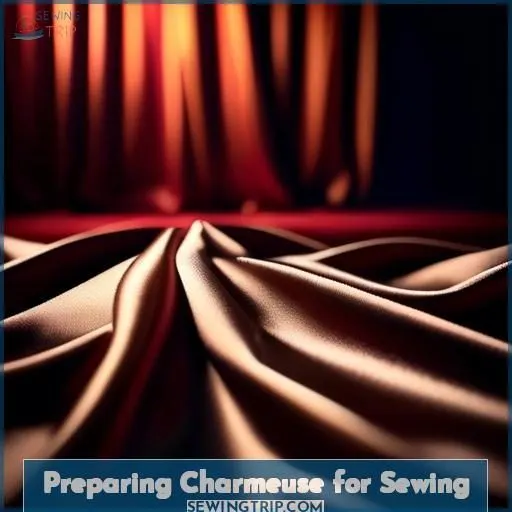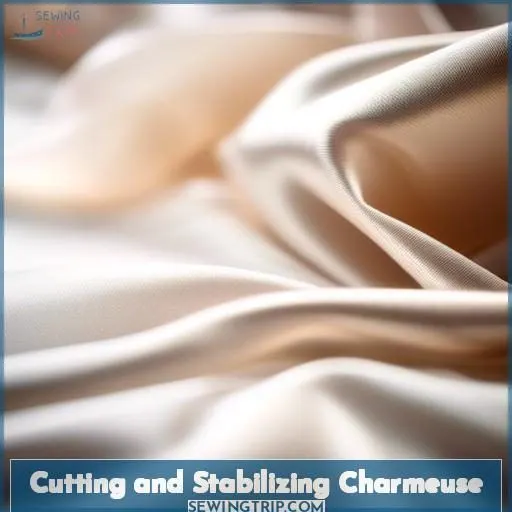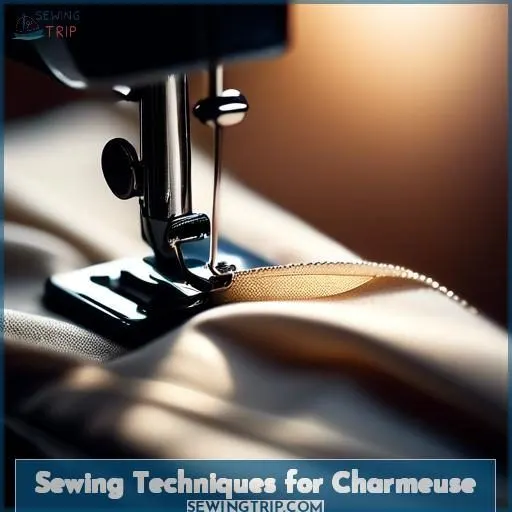This site is supported by our readers. We may earn a commission, at no cost to you, if you purchase through links.

Sewing charmeuse can be challenging due to its delicate, slippery nature. To overcome common problems, start by pre-washing the fabric in cold water and air-drying it flat to minimize shrinkage. When cutting, use serrated scissors and stabilize the fabric with tissue paper to prevent stretching.
For your sewing machine, choose a fine needle and lightweight thread to prevent snags, and adjust the tension settings to accommodate the lighter weight fabric. Implement techniques like French seams and staystitching to encase raw edges and retain shape.
Finally, use finishing touches like bias binding and proper pressing to achieve a professional look.
Table Of Contents
Key Takeaways
- Pre-washing charmeuse in cold water and using a delicate cycle can minimize shrinkage and dye transfer, enhancing the fabric’s manageability for sewing.
- Utilizing serrated scissors and stabilizing the fabric with tissue paper during cutting can prevent the fabric from slipping and ensure precise cuts.
- Selecting a fine needle and lightweight thread, along with adjusting the sewing machine’s tension settings, is crucial to prevent snags and achieve smooth stitching on charmeuse.
- Implementing sewing techniques like French seams and stay-stitching, along with finishing touches like bias binding, can encase raw edges, retain the fabric’s shape, and achieve a professional look.
Preparing Charmeuse for Sewing
Preparing your charmeuse fabric appropriately before sewing is paramount. Cleanse it delicately in frigid water, then suspend it to desiccate and lightly sprinkle with sizing to fortify the fabric.
Pre-Washing Techniques
Pre-washing charmeuse fabric is essential for optimal sewing outcomes. Begin by assessing its colorfastness and potential bleeding. Launder the fabric in cold water using a delicate cycle. Utilize a mesh bag for protection and consider incorporating vinegar into the wash or rinse cycle.
After washing, spread the fabric flat to dry, steering clear of heat and undue tension. Iron it gently, and remember to wash items discretely to avoid dye transfer.
Drying and Ironing Tips
When drying and ironing charmeuse, follow these tips to prevent wrinkles and maintain the fabric’s quality:
- Lay flat on a towel and roll up to remove excess water.
- Unroll and lay flat to dry, avoiding a dryer.
- Iron on a low setting, ensuring the fabric isn’t too hot.
- Use a press cloth to prevent dye transfer.
- Dry time may vary depending on the fabric’s thickness and humidity.
- Record tension, needle, and thread settings for future reference.
- Experiment with blind hem and various stitches to optimize settings.
Cutting and Stabilizing Charmeuse
Cutting charmeuse can be tricky due to its slippery and lightweight nature. To prevent distortion, stabilize the fabric with tissue paper before cutting it with sharp, serrated scissors.
Using the Right Scissors
When cutting charmeuse fabric, it’s essential to use serrated scissors to prevent fabric movement and guarantee clean, precise cuts. Here are three tips for using the right scissors:
- Select scissors with sharp blades that can effortlessly cut through charmeuse without fraying or tearing.
- Handle the scissors with caution to avoid nicking or blunting the blades.
- Maintain the scissors clean and well-cared-for to guarantee they remain sharp and effective for cutting charmeuse fabric.
Stabilizing With Paper
Securing charmeuse fabric is essential for preserving its form and preventing elongation. Paper pinning is a common technique for stabilizing slippery fabric during cutting. However, extracting paper post-sewing can be arduous.
Tissue paper feeding can alleviate this difficulty, though it may not be appropriate for bias-cut pieces.
The table below offers a detailed guide to securing charmeuse fabric, including paper pinning and removal, tissue paper feeding, and cutting stabilization techniques.
Sewing Machine Setup for Charmeuse
Getting your sewing machine set up correctly is essential when working with slippery charmeuse fabric. Pay careful attention to needle and thread selection, as well as tension adjustments, to guarantee the best possible stitching results.
Needle and Thread Selection
Choosing the right needle and thread for charmeuse is like picking the perfect dance partner—it’s all about harmony and balance. Here’s your quick guide:
- Needle sizes matter; fine needles glide through like whispers.
- Thread types should complement, never overpower.
- Fine needles prevent snagging, ensuring elegance.
- Larger needles for bolder statements, sparingly used.
Tension Adjustments
To guarantee smooth sewing with charmeuse, modify your machine’s tension settings. For fabrics with a lighter weight such as charmeuse, employ a lower tension setting, usually 3 or 4.
Fabrics with a heavier weight may necessitate a higher tension, but it’s essential to maintain proper threading and needle choice. Correct threading is fundamental for precise tension.
If you face difficulties, think about using a larger needle, finer thread, or an alternative needle type. Regular machine servicing is pivotal for ideal operation.
Threading Tips
When sewing with silk charmeuse, thread tension is imperative for creating a seamless and polished end result. Here are some guidelines for threading your sewing machine:
- Thread caliber: Utilize high-grade thread for prime outcomes. Gutermann or Coats thread is suggested, as they provide smooth thread that diminishes machine lint and abrasion.
- Thread variety: Opt for a thread that aligns with the weight and texture of your silk charmeuse. For delicate fabrics, utilize a fine thread such as 100-weight, 100% silk spooled threads.
- Thread trajectory: Verify that the thread path is free of any hindrances. Neglecting the take-up lever can hinder stitching, while accumulated thread beneath the fabric signifies a missed take-up lever.
- Thread hue: Coordinate the thread color to your fabric to avoid noticeable stitching lines.
Sewing Techniques for Charmeuse
To maintain the fluid drape of charmeuse, implement French seams to neatly encase raw edges. Make certain the bodice, neck, and armholes are stabilized with staystitching to prevent stretching and distortion.
Implementing French Seams
To implement French seams on charmeuse fabric, first stabilize the slippery material with paper, ensuring bias-cut pieces are handled carefully. Use a new 75/11 machine needle with a straight stitch foot and set the stitch length to 2.0.
French seams provide a neat finish and can be beneficial for underlining, especially when using crepe-backed satin lining. Remember to remove tissue paper after sewing to prevent bulkiness.
Staystitching for Shape Retention
Staystitching is a vital technique to preserve the shape of your garment, especially when using fabrics that are prone to slipping like silk charmeuse. Here are three tips to help you staystitch effectively:
- Staystitch the essential areas: Staystitch the waist, neck, and armholes to prevent stretching and maintain the shape of your garment.
- Use a sharp needle: A sharp, thin needle will slide through the fabric more smoothly, reducing the risk of stretching.
- Staystitch before cutting: After staystitching, lay the fabric flat and pin the pattern pieces to the fabric. Cut the fabric with serrated scissors to avoid stretching the fabric.
Underlining and Lining Considerations
When handling charmeuse, don’t avoid the matter: reinforcing back panels is essential, particularly for that trailing train. Consider crepe-backed satin, merging resilience with sophistication. Manual stitching of lining secures a flawless connection, transforming your garment from domestic to high fashion. Select your lining choices like a genuine fabric connoisseur.
Finishing Touches on Charmeuse Garments
When working with the delicate charmeuse fabric, you’ll need to carefully consider the finishing touches. Proper hemming methods, removal of any stabilizing materials, and a final pressing can make all the difference in achieving a professional-looking garment.
Hemming Methods
To finish your charmeuse creation, consider these hem options: bias binding for a clean edge, blind hem for a nearly invisible stitch, roll hem for a rolled edge, lettuce hem for a gathered look, or baby hem for a simple, narrow hem. Experiment to find the perfect finish for your garment.
Removing Stabilizing Materials
To remove tissue paper from charmeuse fabric after sewing, follow these steps:
- Confirm: Make sure all pins are removed from the garment to prevent snagging or damage to the fabric.
- Slowly pull: Carefully pull the tissue paper away from the fabric, starting at the edges and working your way towards the center.
- Use a dull tool: If the tissue paper is stuck, use a dull tool like a seam ripper or a ballpoint pen to gently lift and remove the paper.
- Sweep away: Once the tissue paper is removed, use a soft-bristled brush or your fingers to gently sweep away any remaining paper fibers or debris.
- Iron the garment: Iron the garment on a low heat setting to remove any creases or wrinkles, ensuring you use a press cloth to protect the fabric.
Remember to handle the charmeuse fabric with care to prevent stretching or damage.
Final Pressing Techniques
To complete your charmeuse creation, master seam finishing. For bias binding, use a rolled hem or top stitching. Choose the right hem weight for your project. Don’t forget to press your seam allowances before hemming. With practice, you’ll perfect the art of charmeuse finishing.
Frequently Asked Questions (FAQs)
What is the recommended stitch length for sewing charmeuse?
Hop to it, friend! For charmeuse, you’ll wanna stitch at a svelte 0 stitch length. Any longer and that slippery sucker will pucker and putt all over the place. Trust me, this is the bee’s knees for taming that tricky fabric.
How can I prevent puckering when sewing French seams on charmeuse?
To prevent puckering when sewing charmeuse French seams, use a lighter touch on the fabric, steer clear of stretching, and keep tension even. Rounding the seam edges can also help smooth things out.
What is the best needle size for sewing charmeuse?
Sewing silk charmeuse like a dream? Opt for a size 60/8 or 70/10 needle – that’s the sweet spot for this slippery fabric. Any smaller and you risk skipped stitches; any larger and you may pucker the delicate silk.
How can I prevent the needle from damaging the fabric when sewing charmeuse?
You can prevent needle damage on delicate charmeuse by using a sharp, fine-tipped needle, reducing tension, and taking it slow. Stitch cautiously, using a light touch to glide the fabric under the needle.
What is the best approach for removing tissue paper after sewing on charmeuse?
Carefully peel away the stabilizing tissue paper once the charmeuse is sewn. Use tweezers to gently lift and remove the paper, being mindful not to tug or pull on the delicate fabric. This will preserve the smooth, unblemished finish.
Conclusion
Mastering the art of sewing charmeuse is like waltzing through a delicate dance. With the right techniques in your toolkit, you’ll glide effortlessly through the challenges posed by this slippery, elusive fabric.
From prepping the material to applying the perfect finishing touches, the steps outlined here will help you conquer the problems sewing charmeuse and elevate your creations to new heights of sophistication.
Embrace the finesse required, and let your charmeuse garments shine with a refined, professional polish.











